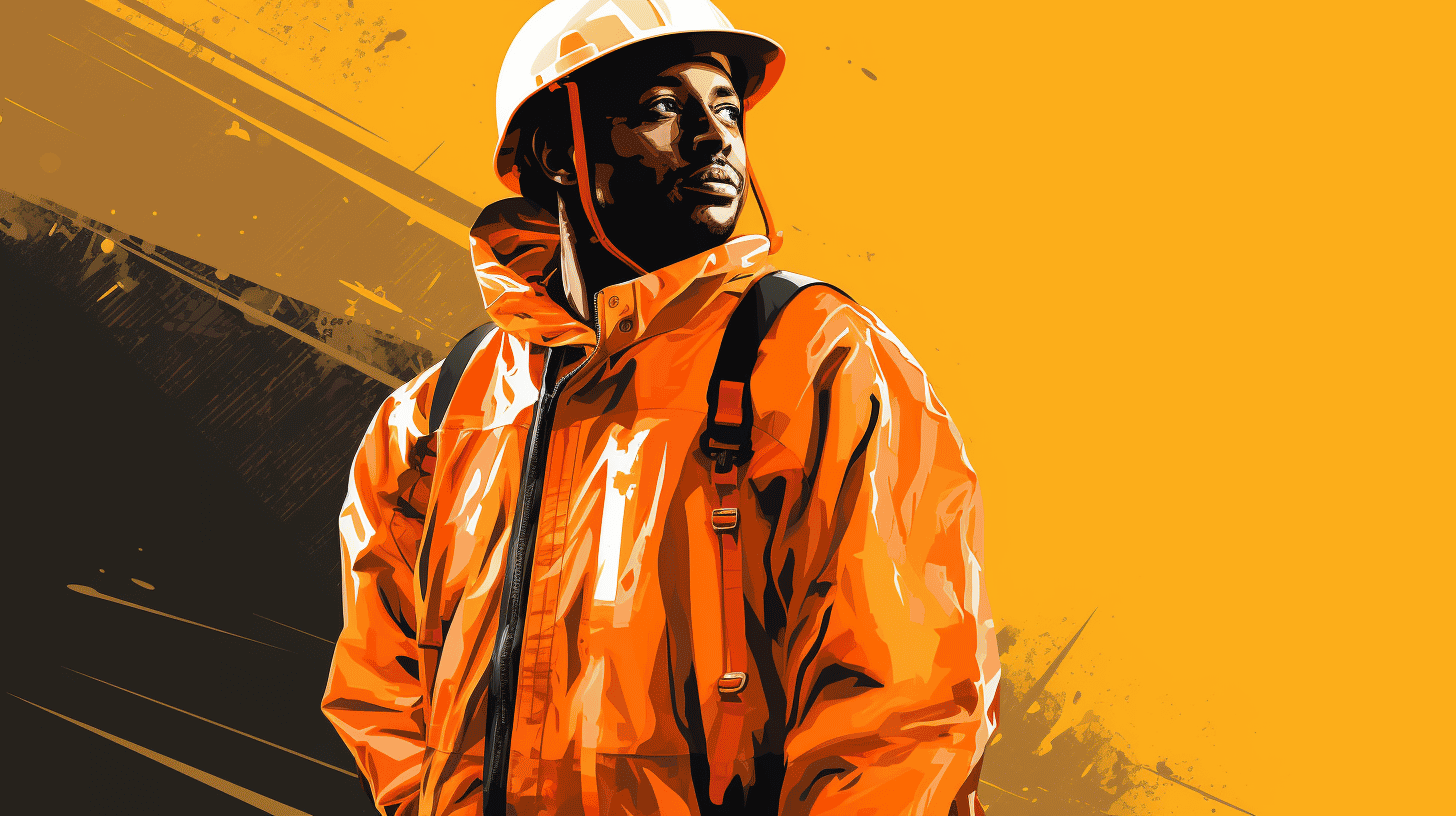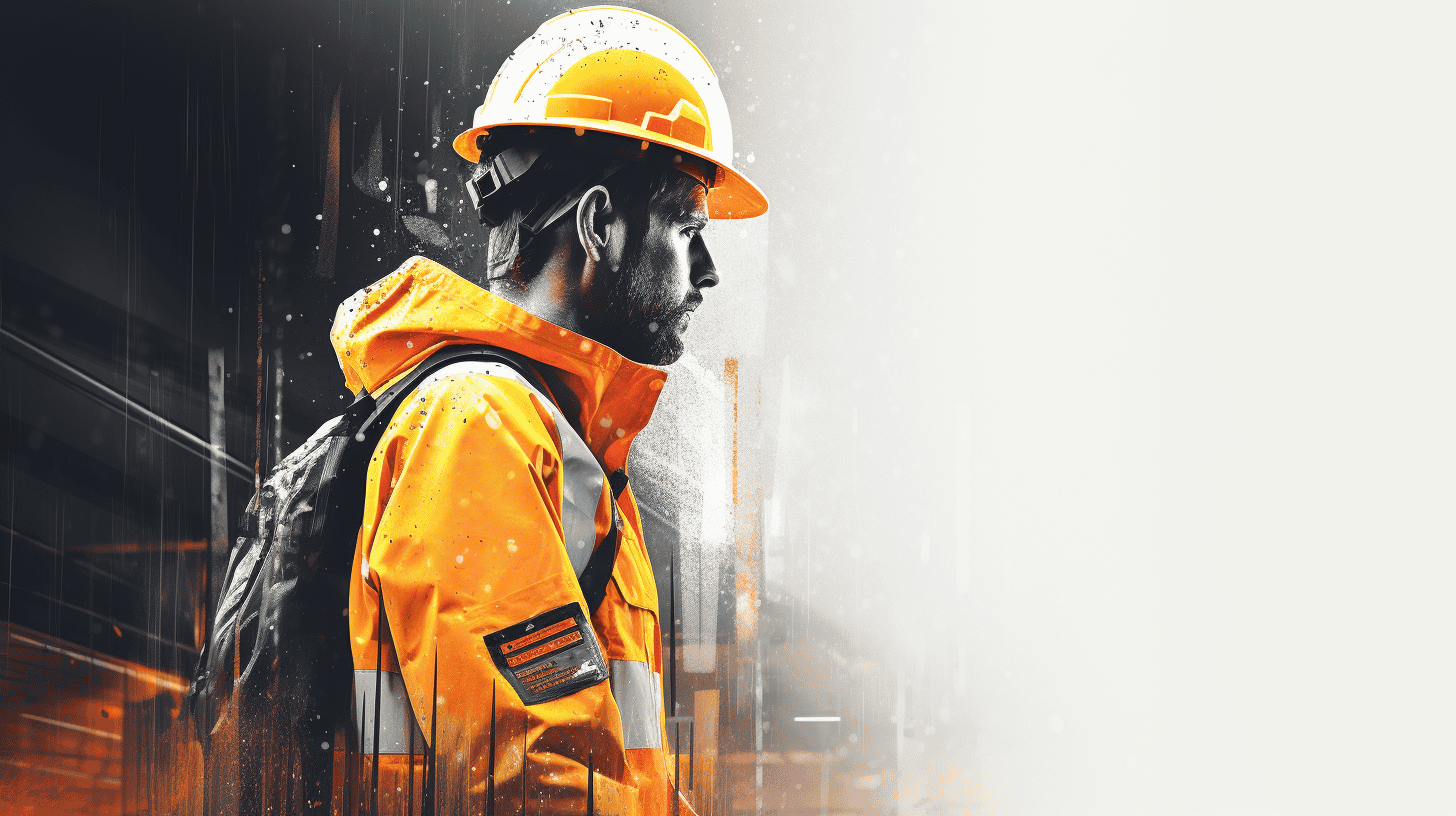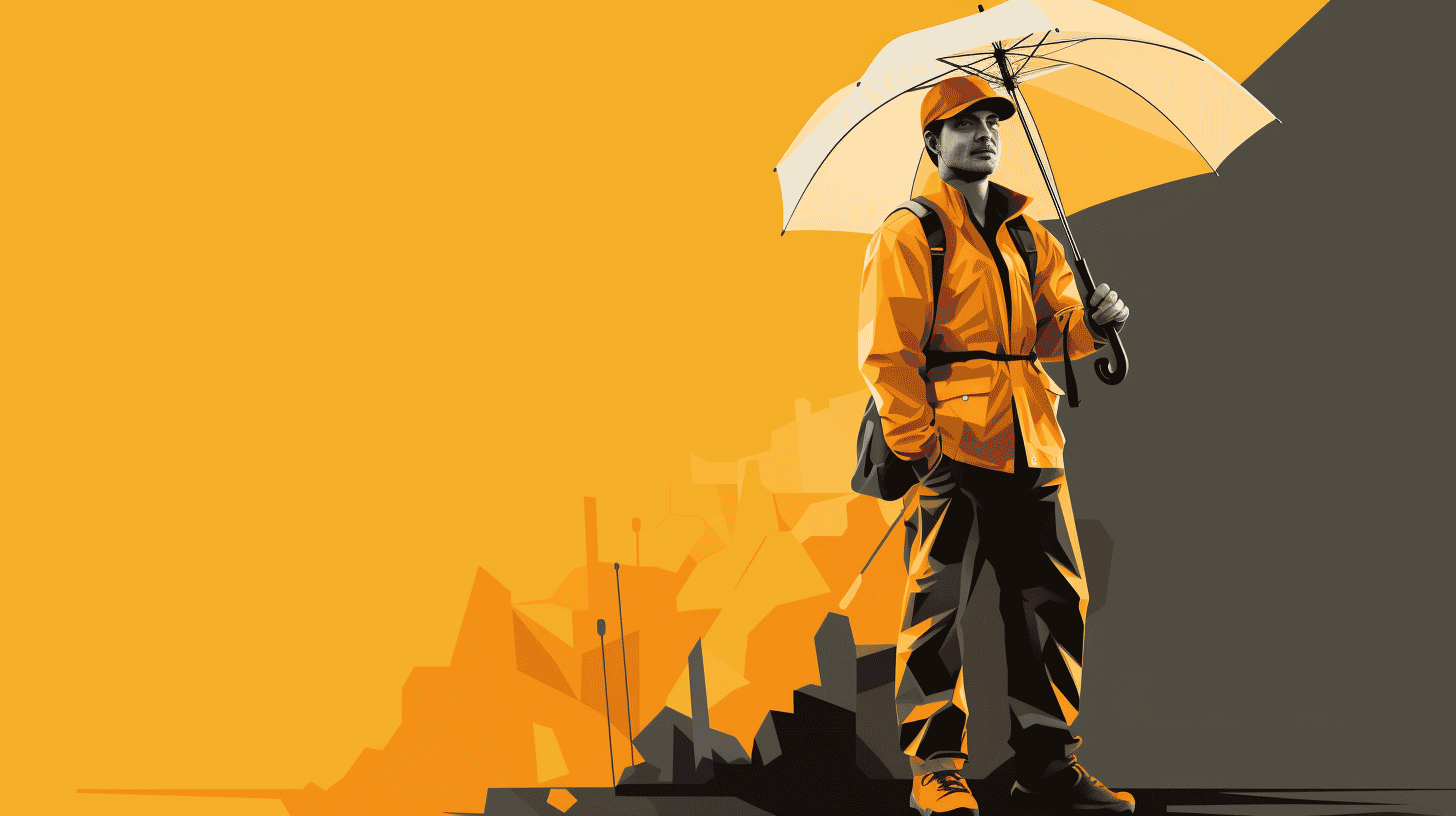Welcome to our insightful dive into rain gear for construction workers—a topic that hits home, especially when rain clouds begin to loom over a busy worksite. As the rain begins to drizzle down, it's essential for construction workers to stay as dry as possible to maintain safety and productivity. Appropriate rain gear—waterproof and durable—provides a shield from uncomfortable and health-threatening conditions.
This article explores the burgeoning rainwear market, the contributing factors to its growth, most notably the changing weather patterns and the ever-increasing consumer demand. We also unveil the latest innovations in rain gear for construction workers, from breathable fabrics to high-visibility reflective strips. The limelight is then put on the emerging demand for eco-friendly rainwear—a paradigm shift worth celebrating for every nature enthusiast.
We'll also assert the efficacy of rainwear specifically for construction workers, outlining how these sturdy rain-resistant uniforms protect workers from the elements and, in doing so, extensively increase the longevity and durability of their gear.
In the world of construction, rain is more than just an inconvenience. Come, let's explore how innovative advancements in rain gear make all the difference, offering workers the protection they need while thriving in an ever-evolving market.
The Current and Estimated Future Position of Global Rainwear Market
Market Evaluation
In recent times, the global rainwear market has seen significant growth and expansion. Considering both small business entrepreneurs and established multinational corporations, rainwear is a sector experiencing exciting developments in terms of innovation and market reach. This growth is projected to continue, where, according to reliable industry predictions, the market will grow at a Compound Annual Growth Rate (CAGR) of 5% from 2023 to 2031. This tremendous growth underscores the growing consumer demand for rainwear products and the increasing recognition of their importance worldwide.
Projected Growth Rate
The consistent development of the rainwear market is projected to sustain an essential positive trajectory in the coming years. With an estimated market worth of $6.4 billion by 2032, a growth rate boasting a CAGR of 5.4%, the predictions are promising. Such an upward trend is directly tied to the essential and ever-growing need for rainwear in climates worldwide, underlying the universal relevance and demand for these products.
Revenue Contribution
Not all regions contribute equally to the global standing of the rainwear market. For instance, North America leads the front with the highest revenue contributions in this sector. With a recorded revenue of $383.0 million, it marks a notable stride, contributing greatly to the overall global market revenues. This significant contribution not only reflects North America's robust presence in the rainwear market but also its potential for continued growth and development.
In essence, the rainwear market's future direction appears promising, thanks largely to its consistent growth, the perceived future growth rate, and significant revenue contributions from certain regions. Therefore, the market's current state and growth predictions paint a picture of an ever-changing enterprise ready to adapt and thrive in the face of necessary climate adaptability measures.
Key Contributing Factors to the Growth of the Rainwear Market
As climate change continues to disrupt weather patterns globally, one particular industry – the rainwear market – is witnessing noteworthy growth. In our exploration into these dynamics, two significant factors have surfaced prominently: Changing Weather Patterns and Growing Consumer Demand. In this article, we delve further into these trends to understand just how they've spurred the rainwear market into its current phase of expansion.
Changing Weather Patterns
Take a look outside the window. The chances are that, these days, you're greeted with bouts of unpredictable weather more often than not. The increasing unpredictability in weather patterns, attributed primarily to climate change, has effectively altered our daily lives and consequently, our wardrobes.
However dire the situation, it has served as a boon for the rainwear industry. With an increase in rainfall and erratic weather, people are increasingly investing in rainwear. Be it stylish umbrellas, waterproof jackets, or sturdy rain boots, buying rainwear has become more of a necessity than a seasonal shopping task.
Segued from the climate crisis, these key points highlight the direct impact changing weather patterns have on the rainwear market:
- Unpredictable Weather - Increasing climate volatility has led to less predictability, making rainwear an essential item for many people year-round.
- Frequency of Rain - Climate change has, in several regions, increased the frequency of rainfall, leading to greater demand for rainwear.
- Severity of Weather Events - More intense weather events, such as storms and heavy rainfall, require durable and waterproof clothing, thereby increasing rainwear sales.
Clearly, the ramifications of our changing ecosystem are having substantial impacts on various industries, including rainwear.
Growing Consumer Demand
The other contributing factor to the growth of the rainwear market is the surge in consumer demand. Today's consumers are discerning and demand more than just functionality. They seek quality, style, and sustainability – all in one package.
Rainwear manufacturers have responded to this growing consumer demand by innovating with new materials and technologies to create products that are not only waterproof but also 'fashion-forward'. Here are some ways this has influenced the market:
- Product Innovation: From reflective rainwear for safety to breathable waterproof fabrics for comfort, manufacturers have introduced a plethora of innovations in their offerings to cater to the diverse needs of the users.
- Sustainability: With rising awareness about the environment, consumers increasingly prefer rainwear made from recycled or eco-friendly materials. Companies are also tapping into this trend, focusing on sustainable practices throughout the production process.
- Fashion Forward: Consumers nowadays don't want to forego style for functionality. As a result, we witness trendy designs and cool patterns in the rainwear section, giving a modern twist to the classic items.
According to our analysis from the market analysis report, the rainwear market growth is no anomaly. Rather, it's the direct result of shifts in our global ecosystem and consumer behaviors. As these trends continue to evolve, they're expected to further impact the industry's growth trajectory in the future.
Such an exploration underscores the importance of understanding market influencers in order to create products and strategies that cater successfully to consumer demands while adhering to the limits our planet can sustain.
Innovation in Rain Gear for Construction Workers
Waterproof and Breathable Fabrics
One of the most significant innovations in rain gear for construction workers regards the fabrication. Today's gear leverages waterproof yet breathable materials—a far cry from the non-permeable plastic ponchos of the past that would leave workers drenched in their sweat. These new fabric advancements strike a perfect balance between keeping the water out and allowing sweat to evaporate.
Breathability is achieved through the fabric's microscopic pores, which are too small for water droplets to penetrate but large enough for water vapor (sweat) to escape. This innovation gives workers the benefit of staying dry, both from rain and perspiration, increasing comfort and productivity on the job site.
High-Visibility Reflective Strips
Visibility is crucial in the construction field, especially during adverse weather conditions. Thanks to innovative rain gear designs, workers can now have improved visibility in the rain. Modern rain gear for construction workers often includes high-visibility reflective strips, strategically positioned to attract the attention of people around the worker, particularly vehicle operators.
These high-visibility reflective strips are an incredible step forward in ensuring worker safety – bright colors and reflective elements make workers conspicuous, reducing risk and ensuring a safer working environment.
Durable Materials
Construction work, by nature, requires individuals to work in varied and often harsh environments. As such, the materials used for rain gear must have durability built into their design. When it comes to these Durable Rain Gear Innovations, modern rain suits leverage robust materials like high-density polyester and rip-stop nylon, which resist wear-and-tear and have a high tear strength, even when wet.
These durable materials are created to withstand the demanding construction environment, offering construction workers a way to work efficiently in the rain without worrying about the gear ripping or failing.
Rain gear for construction workers has seen some impressive advancements over the years, with a focus on increased breathability, enhanced visibility, and improved durability. These innovations are making strides in supporting construction workers in operating efficiently and safely even in unfavorable weather conditions.
The Rising Demand for Eco-Friendly Rainwear
Imagine this: you're walking down the street in your waterproof rain jacket when it starts to drizzle. You're prepared, comfortable and dry. As raindrops bead off your raincoat, have you ever wondered what your favorite piece of practical outerwear is made from? The truth might surprise you - most rainwear is a product of the oil industry, made from materials like nylon and PVC. However, there's a rising trend that's set to change this - eco-friendly rainwear.
Eco-friendly rainwear, as the name suggests, are raincoats, boots, and umbrellas that are made from environmentally-friendly materials. This gives them a smaller carbon footprint compared to their traditional counterparts. What's more, they're just as practical, stylish, and trend-setting as their less-green cousins.
One reason for the surging popularity of eco-friendly rainwear is the increasing consumer awareness about environmental issues. Staying dry no longer needs to come at the expense of the environment.
So, what makes a raincoat eco-friendly? Here's a simple breakdown:
- Materials: Primary made from recycled materials like PET bottles, discarded nylon or natural materials like Organic Cotton or Rubber.
- Production process: Ensuring sustainable manufacturing processes that limit waste and decrease water consumption.
- Longevity: Creating quality products that last longer and don't need to be replaced as often.
Isn't it fascinating that the plastic bottles you recycled could end up as your stylish, waterproof raincoat?
The eco-friendly rainwear industry is not just limited to raincoats either, there's a whole array of green rain boots, umbrellas, and accessories in the market. Brands that produce these items are committed to not just protecting you from the rain, but also taking care of the environment. Isn't it comforting to know that you're contributing to a healthier planet simply by staying dry in a shower?
As we delve deeper into the 21st century, the demand for eco-conscious products, such as rainwear made from recycled materials, is only set to rise. With climate change being a prominent issue, eco-friendly rainwear might just be the chic solution to staying dry while doing our part for the environment.
Effectiveness of Rainwear for Construction Workers
Rain, drizzle, downpour - adverse weather conditions can make a construction worker's day challenging, and there's nothing quite like being soaked while on a complex task. Enter rainwear - a gamechanger in the construction industry. This protective wear is not just about keeping the rain out; it's also about ensuring comfort, practicality, safety, and durability in a demanding work environment. In the following sections, we will delve into two key aspects of construction rainwear that accentuate its necessity and effectiveness: Protection from Rainfall and Durability of Construction Rain Gear.
Protection from Rainfall
An umbrella may ward off a drizzle, but it's hardly a practical solution on a construction site. This is where purpose-built rainwear steps in. Rain gear is designed with special layers and materials that ward off water effectively, keeping the wearer dry regardless of the severity of the weather.
Firstly, skilled construction workers can stay dry under their rainwear, thanks to water-resistant materials such as nylon, polyester, or treated cotton. These materials usually have a coating or layer that prevents water from soaking in.
Secondly, modern rainwear designs factor in drainage too. They are engineered to let water slide off easily, preventing accumulation that could potentially soak through.
Lastly, let's not forget the comfort and fit. Construction rain gear usually incorporates adjustable elements like cuffs, collars, and hems that not only seal out rain but also provide a comfortable fit.
Durability of Construction Rain Gear
Beyond just keeping workers dry, the durability and longevity of rain gear on construction sites is crucial. This gear goes through demanding conditions and must endure all that the job throws at it.
Rain gear for construction workers stands out due to its enhanced features, designed specifically to withstand the demands of the job. For instance, the seams of this gear are usually fortified and double-stitched, providing extra robustness.
Materials chosen for high-quality construction rain gear are known for their toughness and durability. They resist tears and punctures—an absolute necessity on a busy construction site filled with sharp tools and objects.
Moreover, impactful design elements extend the gear's lifespan. For example, many pieces of rain gear incorporate reinforcement in high-stress areas, reducing wear and tear over time.
All these factors combined deliver durability that not just withstands, but thrives in construction site conditions, ensuring workers get the maximum value and safety from their investment. In your quest for choosing the right rainwear, ensure to check out Effective Construction Rain Gear.
The effectiveness of rainwear for construction workers is undeniable, not just in providing protection from rainfall but also in ensuring durability and longevity. Construction rainwear, carefully engineered to withstand harsh conditions, becomes an invaluable part of a worker's toolkit, keeping them safe and productive, whatever the weather.
Conclusion
The future of the rainwear market is no doubt promising, bolstered by changing weather patterns and increasing consumer demand worldwide. The innovation in construction rain gear is a testament to this growth, in which qualities such as waterproofing, breathability, high-visibility strips and durability play crucial roles.
As a construction worker, staying dry and maintaining flexibility and visibility in poor weather conditions is essential. By choosing rain gear that is not only durable and reliable, but also designed for your specific needs, you can enhance your performance and safety at the worksite.
While eco-friendly rainwear is still finding its footing in the market, it’s an exciting avenue for innovation. Companies like Hurricane Raingear are striving to ensure a balance in offering sustainable options and meeting consumer needs for robust and trustworthy rain gear.
Indeed, the effectiveness of rainwear in the construction industry is undeniable. Whether it's protection from rainfall or the durability of the gear, a wise selection can lead to significant improvements in productivity and well-being.
Ultimately, the future is bright - or we might say, dry and comfortable - for those in need of rain gear solutions. The constant advancement in technology from companies, like Hurricane Raingear committed to consumer needs, is shaping a new age of rainwear - as sturdy as they come, and as flexible as you need them to be.
The rain is no reason to halt progress when you're armed with the right gear. After all, the weather always changes - but our commitment to providing superior rain protection doesn’t have to.
Frequently Asked Questions
-
What are some innovative rain gear solutions for construction workers?
Some innovative rain gear solutions for construction workers include waterproof jackets with integrated LED lights for enhanced visibility, breathable and water-resistant rain pants, waterproof boots with reinforced toe caps, and waterproof gloves with touchscreen compatibility.
-
Are there rain gear solutions specifically designed for construction workers?
Yes, there are rain gear solutions specifically designed for construction workers. These solutions often incorporate durable materials, reflective elements for safety, and additional features such as tool pockets and reinforced stitching to withstand demanding construction environments.
-
What are the benefits of using innovative rain gear for construction workers?
Using innovative rain gear provides multiple benefits for construction workers, including protection from rain, wind, and cold temperatures, increased visibility for improved safety, enhanced comfort through breathability and moisture-wicking properties, and durability to withstand the demands of construction work.
-
How do I choose the right rain gear for construction work?
When choosing rain gear for construction work, consider factors such as waterproof or water-resistant materials, breathability, durability, comfort, visibility features, and additional functionalities that align with the specific needs of construction workers. Read product reviews and ensure proper sizing for a perfect fit.
-
Can rain gear be used in other professions or outdoor activities?
Yes, rain gear designed for construction workers can be used in various other professions or outdoor activities that require protection from rain and harsh weather conditions. Examples include landscaping, road maintenance, farming, hiking, and camping.























Leave a comment
This site is protected by hCaptcha and the hCaptcha Privacy Policy and Terms of Service apply.